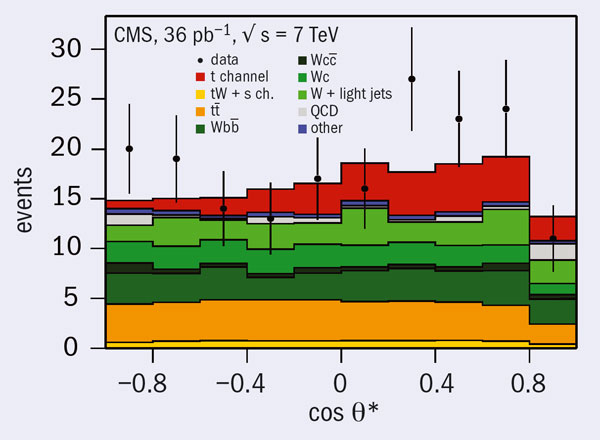
The top quark was first observed in the mid-1990s by the CDF and DØ experiments at the Tevatron collider at Fermilab. These were produced and observed as top-antitop pairs, but it was not until 2009 that the two experiments reported the observation of single-top quarks. The ATLAS and CMS experiments at the LHC reported the first signs of top-antitop last summer, just a few months after the first collisions at a centre-of-mass energy of 7 TeV. Now, CMS has completed two complementary single-top analyses using the full data sample of 2010; that is, an integrated luminosity of 36 pb–1.
Such single tops are much more difficult to observe experimentally because they are produced at a lower rate and have a less distinctive signature compared with top-antitop pairs. This makes it more difficult to distinguish single-top events from the background physics processes.
In their recent analyses, the CMS collaboration focused on the production of single top via the so-called “t-channel W boson exchange” process in which the top quark emerges from the exchanged W together with a light quark. They observed the top quark through its decay into a W boson and a b-quark. The W boson was detected in turn through its decay to a charged lepton (electron or muon) plus a neutrino, while the jet from the b-quark was tagged by the high-precision silicon tracking detectors in CMS.
The two analyses establish the observation of single-top production by CMS with a statistical significance of about 3.5 σ. One analysis exploited the angular characteristics between the light quark jet and final-state lepton, shown in the figure, while the other used a multivariate analysis technique to separate the signal from the background. Data-driven background estimates were used in both these analyses. The two analysis methods were combined to yield a cross-section for single-top production in proton–proton collisions at 7 TeV of 83.6± 29.8 (stat+syst.)± 3.3 (lumi.) pb. This result agrees well with the rate predicted by the Standard Model.
Such a rapid detection of the elusive single top, despite the challenging background conditions, shows that the experiments are well prepared to detect and measure signals of new physics. These may soon manifest themselves as the LHC continues to produce ever more data at the high-energy frontier.








